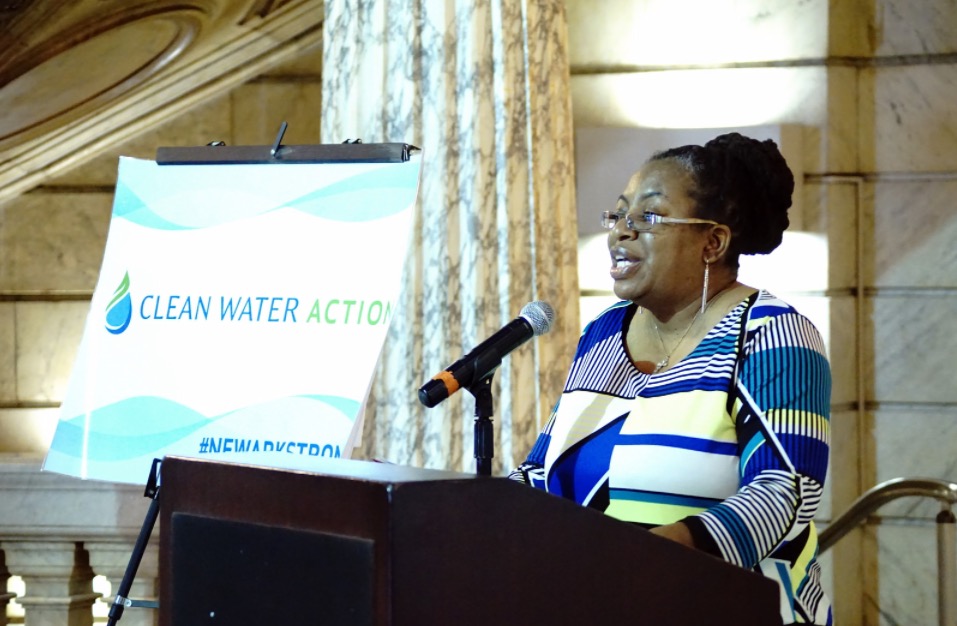
Washington DC: Clean Water Action was honored to attend today’s first-ever Congressional Convening on Environmental Justice hosted by Chairman Grijalva, Rep. McEachin, and the House Committee on Natural Resources. Watch the live stream here: http://bit.ly/2FrZWVu (morning) http://bit.ly/2xhVKTr (afternoon).
Kim Gaddy, Clean Water Action’s Environmental Justice (EJ) Organizer, joined other environmental justice, climate justice, public health, and faith advocates, to speak as a panelist entitled: Environmental Justice Policy Challenges: How we scale up positive change through legislation. Gaddy has been advocating for port communities impacted by industrial pollution of our waterways and diesel truck, train and ship pollution of our air, in Newark and across the country for 18 years.
“Communities of color and low income neighborhoods bear the greatest burden of pollution which harms their health, quality of life, ability to thrive, learn and work, ” said Gaddy. “I’m honored to lift up the voices for frontline communities today and help Congress develop and implement policies to address these injustices.”
The first convening of its kind, the Environmental Justice Summit provided a venue for community activists and environmental justice practitioners to communicate their needs to members of Congress and their staff, who will commit directly to addressing long standing inequities in economically oppressed and politically marginalized communities. The conversation will produce a set of principles to inform environmental justice legislation to be introduced later by Congress.
At the convening, Kim Gaddy Environmental Justice Organizer forClean Water Action made the following recommendations to Congress:
-
Regarding environmental justice and agency rule-making, on paper the U.S. Environmental Protection Agency (EPA) is supposed to follow the 1994 Executive Order on Environmental Justice (EO 12898). In doing so, the EPA must consider how its policies could disproportionately impact frontline/EJ communities in order to avoid and eliminate any impacts. But in reality, the EPA has a very poor track record regarding implementation.
-
In establishing water, sewer, transportation and energy infrastructure improvements and related funding, policies must specify mandates to do no harm and provide positive benefits first to EJ communities, and not make improvements in one location at the expense of EJ communities.
-
Adopt policies that mandate significant reductions in the cumulative impacts and exposure to multiple sources of pollution. This situation occurs almost exclusively in low-income and communities of color.
-
Require environmental justice, civil rights protections, and health-related safeguards in all federal spending and policy.
-
Ensure a fully funded federal budget for clean water and drinking water appropriations, environmental enforcement, and drinking water system assistance (SRFs), with special emphasis on highly vulnerable and disproportionately impacted communities of color and low income.
-
Stop the administration from dismantling critical environmental protections including all of the Clean Water Act rollbacks such as the Dirty Water Rule and EPA Polluter Loophole and environmental rollbacks for coal ash, oil and gas, and the Steam Electric Power Generating Effluent Guidelines (ELG) rule.
-
Strengthen and broaden, not weaken or eliminate, National Environmental Policy Act (NEPA) for federal infrastructure projects.
-
In regards to Environmental Impact Statements under the National Environmental Policy Act (NEPA), Congress must provide, impacted community residents with ample opportunity to engage and develop a community benefits agreement that codifies an acceptable alternative, mitigates harms and eliminates anticipated environmental injustices related to proposed projects.
“Upstream pollution is most likely to harm the most vulnerable populations,” said Gaddy. “We must require all legislative acts to advance self-determination by engaging with EJ communities in a meaningful way and supporting community solutions.
Residents in frontline communities must speak for themselves, participate and determine what their communities look like, said Gaddy.
Clean Water Action is also calling on Congress to ensure that infrastructure and transportation investments prioritize and address the health conflicts in EJ neighborhoods. Currently, infrastructure and transportation bills fund projects that have no civil rights protections, safeguards, or oversight to avoid or address EJ impacts in front line communities.
“For example, the Port of NY & NJ Bayonne Bridge raising and the Army Corps deepening project at the port to accommodate bigger supersized Panamax ships brings in more pollution and adds significantly more truck activity (previously 14,000 truck trips per day, now 18,000), but have no additional requirements for reducing or eliminating ship and truck emissions,” said Gaddy. “These types of protections for port impacted communities should be included in bills, permits and bills that fund these types of projects.”
Diesel emissions in communities surrounding the Port of NY & NJ are linked to asthma, cancer, and other health disorders, causing 21,000 premature deaths each year. Families that live by busy diesel truck corridors and port communities are often hit the hardest.
“The U.S. EPA must require port and freight facilities to meet clean air standards so that their deadly diesel emissions - causing asthma, lung cancer, heart disease, strokes, and neurological disorders - are eliminated,” said Gaddy. “Commercially viable zero emissions technology now exists to make this possible today.”
###
Since our founding during the campaign to pass the landmark Clean Water Act in 1972, Clean Water Action has worked to win strong health and environmental protections by bringing issue expertise, solution-oriented thinking and people power to the table. We will protect clean water in the face of attacks from a polluter friendly Administration and Congress. Clean Water Action has 150,000 members in NJ and nearly 1 million nationwide. www.cleanwater.org/nj